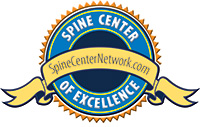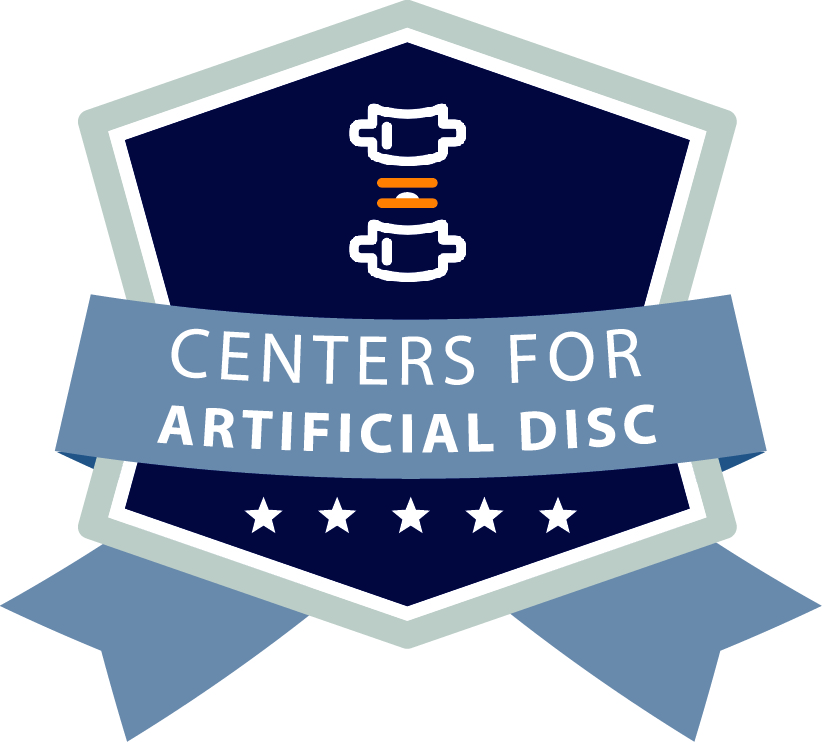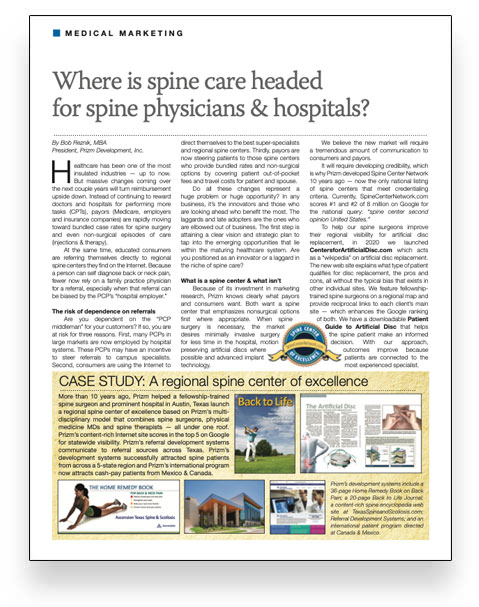- 817-481-2450
- Contact Us
-
Hospital & ASC Service Lines
Developing a NEURO service line for a hospital or ASC
The challenge for a hospital in developing a neuroscience service line is addressing the two disparate capabilities that are common to a neurosurgeon but have nothing in common to the consumer using the service line.
The fact that a neurosurgeon trains in cranial work as well as spine surgery is lost on the befuddled back pain patient in the waiting room who may be sitting next to a brain tumor patient.
The trap door to failure is even more evident with work comp. If reimbursement for work comp is lucrative in that state, the spine center would naturally position itself as the referral point for local employers. This would put the back pain patient who is injured on-the-job (33% of on-the-job injuries are back related) sitting in work boots and overalls next to a stroke patient. Then further along in the treatment algorithm, picture all these disparate patient types in one therapy area.
Developing a “Brain and Spine Center” represents silo bias, and reflects a myopic strategy that the hospital is providing a service based on the training silo of the neurosurgeon rather than the unique challenges posed by patients with back or neck pain, or those patients with the very wide array of neuroscience-related problems (brain tumor, brain injury, stroke, epilepsy, brain cancer, aneurism, etc.)
While lumping all this together in one space may seem to be the easiest way to “check the box” and move along with the next service line, such a brain/spine program will NEVER be as strong competing against either a pure-play, freestanding ortho-based spine center in the marketplace OR even a competing hospital’s pure-play neuroscience program that is set up correctly for the need of the neuroscience center patient.
For example, Prizm has had great success launching pure-play spine programs in a major urban city and capturing spine market share from a “brain & spine center”. That type of program is simply not specialized to the need of the person using the service line, but rather is specialized to the need of the provider.
Secondly, the TEAMS involved for spine and neuroscience are completely different, with the only common denominator being the neurosurgeon. For example:
The Spine Team:
The core spine team of a successful spine center service line would include:
- Spine surgeons — Fact: Payors/employers nationwide all view spine surgery as inclusive of ortho and neuro, not just one or the other. Consequently, a less myopic vision would see at maturity a destination center for spine evolving over 5 years to including BOTH ortho and neuro. This programmatic design would become the strongest regional competitor for spine — IF THAT IS INDEED THE GOAL.
- Spine-trained PMR — The market reality is that Physical Medicine & Rehabilitation is now extremely sub-specialized with PMR physicians specializing in either spine, sports medicine, ortho or neuro (stroke), but not generalizing in ALL of these niches.
- Spine therapy — These are guru specialists in MacKenzie, Maitland, Grimsby, Cyriax, Paris, etc. All of these highly trained therapists have nothing to do with, or any interest in, stroke and other neuro rehabilitation issues.
The Neuroscience Team:
The core team of a successful neuroscience service line could include:
- Neurosurgeons
- Neurologists
- Internal Medicine
- PMRs specializing in stroke
- Therapists who specialize in recovery from stroke and other brain injury
- Oncologists
Thirdly, the development of the neuroscience center is done differently than that of a true spine center. Referral development and direct-to-consumer messages are different. The targets are different, in that employers can steer on-the-job back injuries. Not typically the case with brain tumor, brain cancer, stroke, etc. which can enter the system through the emergency room or referral from physicians who might not ever see back or neck pain.
Space planning issues:
With the above said, it IS possible to have both programs under the same roof, sharing a core administrative team and core clerical team to reduce duplicate overhead, but with different doorways, different waiting rooms, separate exam pods and separate therapy areas. This is a branding and product development issue that Prizm addresses in the development of the two programs.
In summary, everything depends on if the vision of the service line is to be the regionally dominant provider of spine and neuroscience, as this affects the strategy for how the program is space-planned and developed.
Disclaimer:
The pictures displayed in this website are images of physicians, patients and employees who have consented to have their pictures in this website. If you are viewing in Internet Explorer 8 or older you may need to update your browser.
HAVE A QUESTION?

Wouldn’t it be convenient if someone created a listing of spine centers of excellence across the United States that all emphasize non-surgical treatment options before surgery?
Finally, there is a place.

Centers for Artificial Disc is the only verified national listing of spine centers that specialize in artificial disc replacement surgery.
CentersForArtificialDisc.com